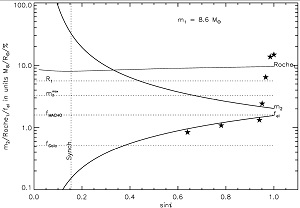The VLT-FLAMES survey of massive stars. NGC2004#115: A triple system hosting a possible short period B+BH binary
- Details
- Published on 09 September 2022
Vol. 665
7. Stellar structure and evolution
The VLT-FLAMES survey of massive stars. NGC2004#115: A triple system hosting a possible short period B+BH binary
 The star NGC2004#115 in the Large Magellanic Cloud, originally classified as a Be spectroscopic binary (SB1), bears some morphological resemblance to the Galactic systems LB-1 and HR 6819, both of which have been proposed to be either a Be+black hole (BH) or, perhaps more likely, Be+stripped He-star systems. Multi-epoch optical spectra of NGC 2004#115 from the ESO/VLT and SALT telescopes, separated by a baseline of ~20 years, allowed the authors to conclude that it is a triple system consisting of an inner binary with a period of 2.92d, an eccentricity close to 0, and a mass function ~0.07 Msun. The inner binary hosts a B-type star (the primary) with a projected rotational velocity of 10km/s and a luminosity log(L/Lsun)=3.87, which contributes ~60% of the total V-band light. The secondary is not detected, while the tertiary, which therefore contributes the other ~40% of the light, is tentatively identified as a slightly less luminous B-type star with a high projected rotational velocity. Assuming the primary to be a main sequence star yields a mass of 8.6 Msun, while stringent limits on the absence of ellipsoidal light variations enabled by MACHO and Gaia data allowed for the construction of the accompanying diagnostic figure. Applying the additional constraint of synchronous rotation leads to the conclusion that the inclination is almost pole-on with i~9 degrees, implying that the secondary is a BH with a mass of ~25 Msun. A low mass stripped star with a similar luminosity is ruled out as a potential solution as its mass implies a Roche radius that is substantially smaller than the stellar radius. The authors suggest that the outer period probably exceeds 120 days and, while the disk-like emission is variable (it is almost absent in the SALT dataset), it may be associated with the inner binary rather than the rapidly rotating tertiary. XMM-Newton provides an upper limit of 5e33 ergs/s, which is consistent with, though not constraining, the system hosting a quiescent B+BH binary. The authors discuss a number of caveats to this scenario in their paper.
The star NGC2004#115 in the Large Magellanic Cloud, originally classified as a Be spectroscopic binary (SB1), bears some morphological resemblance to the Galactic systems LB-1 and HR 6819, both of which have been proposed to be either a Be+black hole (BH) or, perhaps more likely, Be+stripped He-star systems. Multi-epoch optical spectra of NGC 2004#115 from the ESO/VLT and SALT telescopes, separated by a baseline of ~20 years, allowed the authors to conclude that it is a triple system consisting of an inner binary with a period of 2.92d, an eccentricity close to 0, and a mass function ~0.07 Msun. The inner binary hosts a B-type star (the primary) with a projected rotational velocity of 10km/s and a luminosity log(L/Lsun)=3.87, which contributes ~60% of the total V-band light. The secondary is not detected, while the tertiary, which therefore contributes the other ~40% of the light, is tentatively identified as a slightly less luminous B-type star with a high projected rotational velocity. Assuming the primary to be a main sequence star yields a mass of 8.6 Msun, while stringent limits on the absence of ellipsoidal light variations enabled by MACHO and Gaia data allowed for the construction of the accompanying diagnostic figure. Applying the additional constraint of synchronous rotation leads to the conclusion that the inclination is almost pole-on with i~9 degrees, implying that the secondary is a BH with a mass of ~25 Msun. A low mass stripped star with a similar luminosity is ruled out as a potential solution as its mass implies a Roche radius that is substantially smaller than the stellar radius. The authors suggest that the outer period probably exceeds 120 days and, while the disk-like emission is variable (it is almost absent in the SALT dataset), it may be associated with the inner binary rather than the rapidly rotating tertiary. XMM-Newton provides an upper limit of 5e33 ergs/s, which is consistent with, though not constraining, the system hosting a quiescent B+BH binary. The authors discuss a number of caveats to this scenario in their paper.

